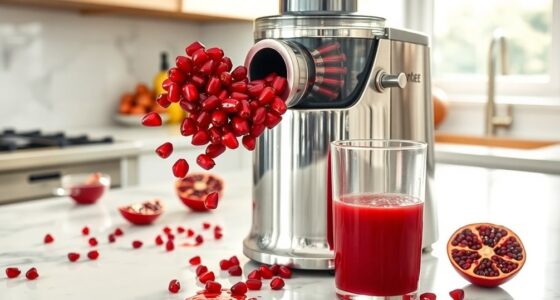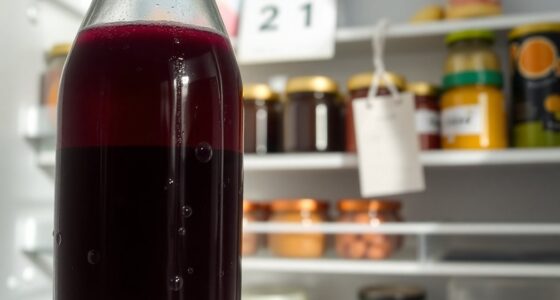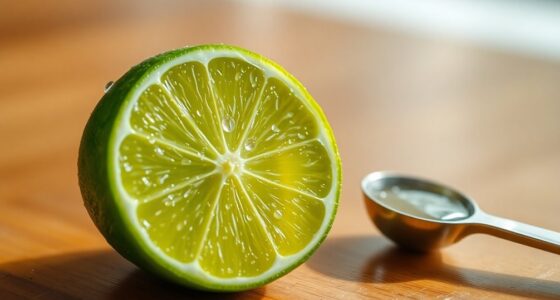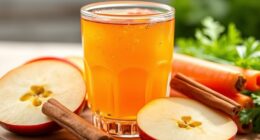Juice shouldn't be left out of the fridge for more than two hours. If it's a hot day, like over 90°F, that time drops to just one hour. Fresh-squeezed juice is especially vulnerable to spoilage, while store-bought juice is more resistant due to its acidity. Leaving juice out increases the risk of harmful bacteria and diminishes its nutritional value. To keep your juice safe and fresh, there are best practices you should consider.
Key Takeaways
- Juice should not be left out at room temperature for more than two hours to prevent spoilage and bacterial growth.
- Fresh-squeezed juice is more susceptible to spoilage than store-bought juice due to the lack of pasteurization.
- In temperatures over 90°F, juice should not be consumed after being left out for more than one hour.
- Opened store-bought juice must be refrigerated within two hours to ensure safety and quality.
- Discard any juice that has been left unrefrigerated beyond the recommended time frame to avoid health risks.

Have you ever wondered how long juice can sit out before it goes bad? It's a question that many people ask, especially when they're enjoying a refreshing glass of orange juice. The truth is, the shelf life of juice, particularly orange juice, can be quite limited when left at room temperature. If you leave your juice out for too long, you risk not only spoilage but also the growth of harmful bacteria that can lead to foodborne illness.
When it comes to orange juice, the general rule is that it shouldn't be left out at room temperature for more than two hours. This is especially important if you're dealing with fresh-squeezed or unpasteurized juice. Fresh juice lacks the pasteurization process that kills off harmful bacteria, making it more susceptible to spoilage. If fresh orange juice is left unrefrigerated for over two hours, it's best to toss it out.
Even though store-bought orange juice is acidic, which does help minimize bacterial growth, it can still spoil after just a few hours at room temperature.
If the temperature exceeds 90°F, the safe window for leaving juice out shrinks to just one hour. This is crucial to remember during hot summer days or gatherings where drinks might be left unattended. You wouldn't want to risk your health or that of your guests by serving juice that's been sitting out too long.
So, what about unopened juice? If you've got a carton of pasteurized orange juice that accidentally spent a few hours outside the fridge, you may be in luck. Unopened pasteurized juice can typically be returned to the refrigerator as long as it hasn't been left out for too long.
However, once you open that carton, the game changes. Opened juice should be consumed or refrigerated within two hours to ensure its safety and quality.
Nutrition is another factor to consider. While juice can be a good source of vitamins, especially vitamin C from orange juice, leaving it out for extended periods diminishes its nutritional value. The longer it sits out, the greater the chance for nutrient degradation, which isn't ideal if you're looking to nourish your body.
Frequently Asked Questions
Can I Drink Juice Left Out Overnight?
You shouldn't drink juice that's been left out overnight. It poses a significant health risk due to potential bacterial growth.
The FDA warns that perishable items shouldn't sit at room temperature for more than two hours. Even if it looks and smells okay, harmful bacteria could be present, making it unsafe.
To keep your juice fresh and safe, always refrigerate it after opening and consume it within a week.
Stay safe!
Can We Drink Juice After 5 Hours?
Imagine sipping a refreshing juice, only to discover it's been sitting out too long. You really shouldn't drink juice after five hours.
At that point, harmful bacteria could have started to multiply, making it unsafe. Even if it looks fine, the risk isn't worth it.
Stick to the two-hour rule to keep your drinks safe and tasty. When in doubt, throw it out—your health deserves better than a gamble!
How Fast Does Juice Go Bad?
Juice goes bad faster than you might think. If you leave it out at room temperature, it can start to spoil within just a couple of hours.
Fresh-squeezed juice is especially vulnerable, so you'll want to be cautious. Signs of spoilage include a strange smell, off-tasting flavors, or even visible mold.
If you notice any of these changes, it's best to toss the juice rather than risk your health. Always check before sipping!
How to Pack Fresh Juice for School?
To pack fresh juice for school, use a well-sealed, insulated container to keep it cool.
Add ice packs or frozen fruit to maintain a temperature below 40 degrees Fahrenheit. Aim to drink the juice within two hours of packing to ensure safety.
Label the container with the date and time, so you can track its freshness. If you're concerned about spoilage, consider using pasteurized juice, which lasts longer without refrigeration.
Conclusion
In summary, juice can safely sit outside the fridge for a short spell, usually around two hours. However, if the sun's shining or the heat's high, that time shrinks to just one hour. Remember, when juice's warmth welcomes worry, it's wise to toss it out. So, keep your cool and store your sips in the chill, ensuring your refreshing drink remains deliciously delightful, not a dangerous dilemma. Happy sipping!
Cindy thoroughly researches juicing trends, techniques, and recipes to provide readers with practical advice and inspiration. Her writing style is accessible, engaging, and designed to make complex concepts easy to understand. Cindy’s dedication to promoting the advantages of juicing shines through her work, empowering readers to make positive changes in their lives through the simple act of juicing.











